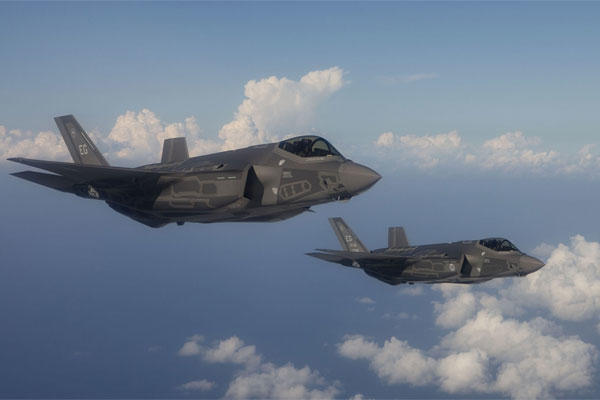PARIS -- Lockheed Martin Corp. has reassigned 200 engineers to work on the F-35 fighter jet's software, a problem area that Defense Department officials fear could cause more delays to the program.
The Bethesda, Md.-based company, the world's largest defense contractor, permanently assigned the employees to the Joint Strike Fighter program, according to Steve O'Bryan, vice president of F-35 program integration and business development. Many came from outside the aeronautics division, with specialties in space, ship-board, and sensor technology, he said.
"We pulled the best and brightest from throughout our organization," he said Wednesday during a press conference at the Paris Air Show.
The company has also invested $100 million to build a second laboratory, where the employees work in shifts around the clock to write, test, and verify the code, O'Bryan said.
"We've established two labs," he said. "They're running 24-7, what we call lights out."
The Joint Strike Fighter is the Pentagon’s most expensive weapons acquisition program, estimated cost of $391 billion to develop and build 2,457 Lightning II aircraft. That's $4.5 billion, or 1.1 percent, less than a projection from last year due in part to revised labor rates.
The single-engine jet designed to replace such aircraft as the F-16, A-10, F/A-18, and AV-8B.
The Defense Department next year plans to spend $8.4 billion to buy 29 F-35s, including 19 for the Air Force, six for the Marine Corps, and four for the Navy. The funding includes $6.4 billion in procurement, $1.9 billion in research and development, and $187 million in spare parts.
Rep. Tammy Duckworth, D-Ill., earlier this month unsuccessfully sought to freeze procurement funding for the program until Defense Secretary Chuck Hagel certified that Lockheed fixed problems with the aircraft’s software and several pieces of hardware, including the helmet-mounted display, fuel dump system and arresting hook.
“I want contractors to be held accountable and I want to fix the technical problems before we give them another $6 billion of taxpayer money,” she said during a hearing to amend the House's version of the 2014 defense authorization bill. “There’s nothing wrong with flying before we buy. In fact, most of us test drive cars before we [buy].”
The panel voted against her amendment to the legislation, which sets policy goals and spending targets for fiscal 2014, which begins Oct. 1.
Air Force Lt. Gen. Christopher Bogdan, who manages the F-35 program for the military, told lawmakers in April that he's concerned the slow pace of software development may delay the delivery of the most lethal version of the F-35 fighter jet beyond 2017.
By using a more limited version of the software, the Marine Corps plans to begin operational flights of the fighter jet in 2015, followed by the Air Force in 2016 and the Navy in 2019.
The F-35 requires more than 8 million lines of code, compared with about 2 million for the F-16 and less than 1 million for other fourth-generation fighter aircraft, O'Bryan said.
"The key to it is finding a defect or changes to the software earliest in the process that you can," he said of the testing. "You want to find it in the lab versus on the F-35."
Software is first tested on individual systems aboard aircraft such as Boeing Co.'s Sabreliner or British Aircraft Corp.'s One-Eleven, called the BAC-111, and then on a group of integrated platforms aboard Lockheed's Cooperative Avionics Test Bed, called the CATBird, a modified Boeing 737, O'Bryan said.
As the pilot is "flying all the missions systems and working the software, there are 20 engineering stations behind him, where software engineers get to see the performance of the software in flight," he said. "Obviously, this is much less expensive than flying a test airplane in flight and you're able to accomplish a whole host of things that you can't do on just one F-35 flight."
When asked whether the number of reassigned engineers was enough, O'Bryan said, "So far, we're on track." The company will have a better idea after a critical review this summer of the most advanced software package, known as 3F, he said.
"That will give us the data to instill confidence -- Do we have the right schedule? Do we have the right funding and personnel to meet Block 3F on time?" he said.
The full software package is designed to support a suite of internal and external weapons, including the GPS-guided Joint Direct Attack Munition, laser-guided Paveway II bomb, Advanced Medium-Range Air-to-Air Missile, and infrared Sidewinder missile.






























